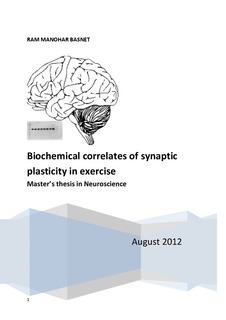Biochemical correlates of synaptic plasticity in exercise
Abstract
Current views of the brain are shifting towards a more changeable, plastic brain than previously envisaged. Physical training has been shown to be one of few strategies that seems able to increase the plasticity of the brain. Little is known, however, about the molecular mechanisms that regulate synaptic plasticity during training. The aim of the project is to explore training based synaptic plasticity at a molecular level, focusing primarily on the excitatory glutamatergic synapses. Most of the research done on exercise has been focused on a specific brain region. I have tried to investigate global effects of exercise on the synapse.
Crude synaptosomes were prepared from trained and sedentary groups of mice, and semiquantitative western blotting was done to determine possible changes in synaptic expression of functionally crucial proteins, i.a. glutamate receptors.
I found increased level of syntaxin, GluR1 AMPA receptor subunits, and the 2A/2B subunits of the NMDA receptor. There was also a decreased level of Arc in trained compared to sedentary mice. There was no significant change in the expression of the neuronal marker, beta tubulin, of the synaptic markers synaptophysin and PSD-95, or in the AMPA receptor subunit GluR2. Taken together, my results may indicate that physical exercise may lead to an increased level of ongoing hebbian plasticity, a reduction in homeostatic plasticity, an increased presynaptic release capacity, with no apparent change in the density of neurons or synapses.
